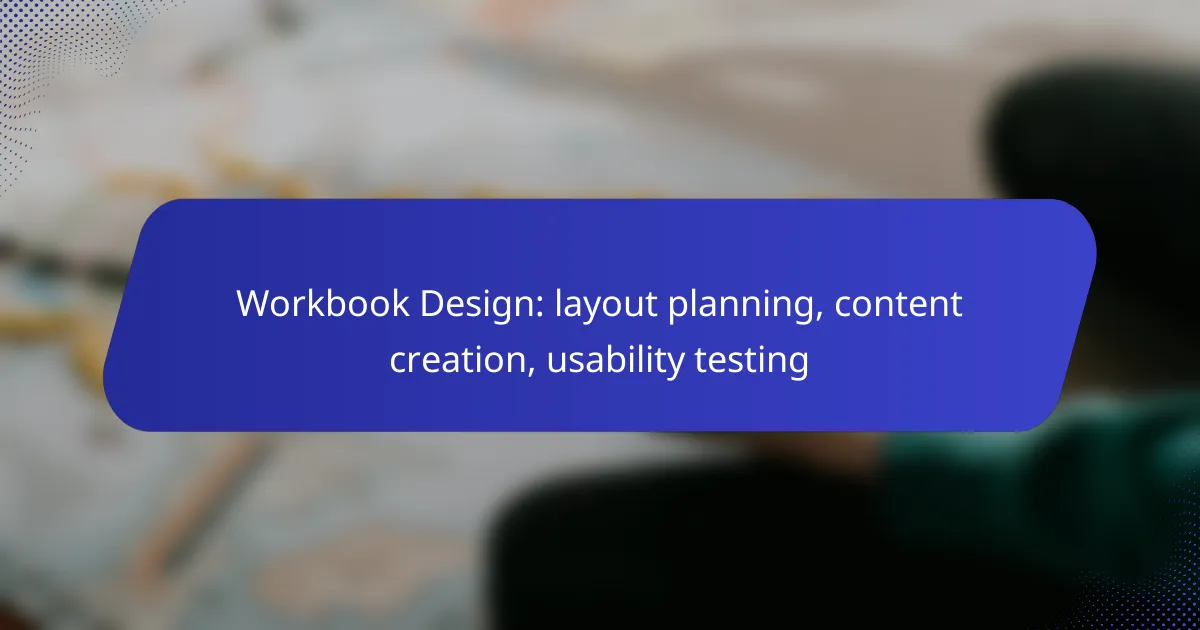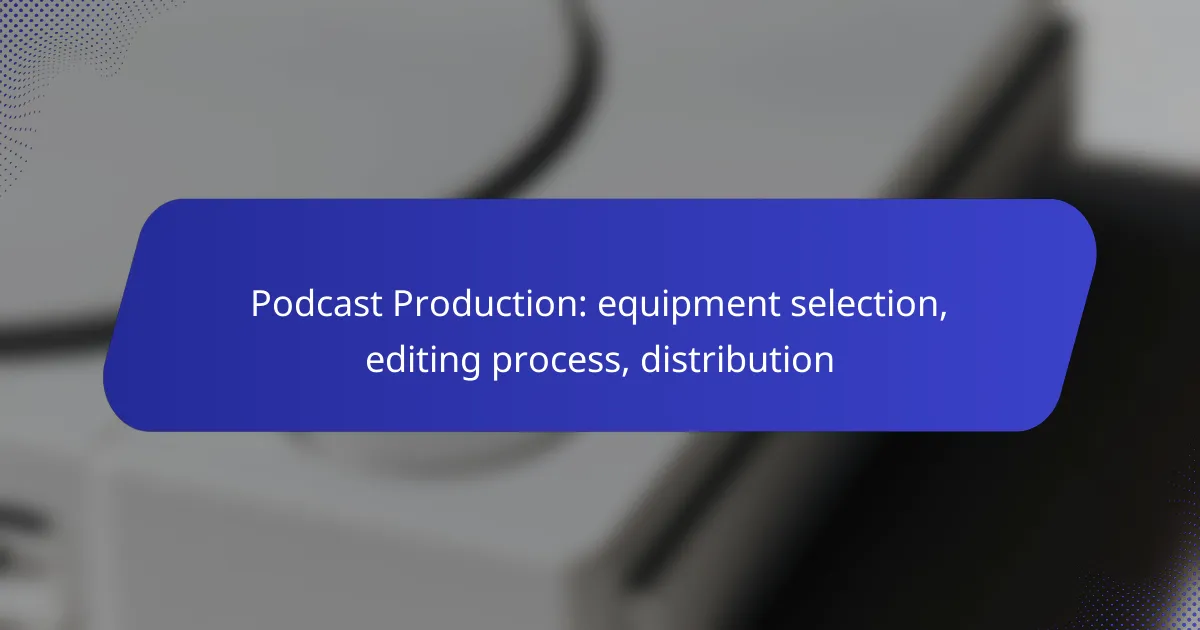Designing an effective workbook requires careful consideration of layout, content, and usability to enhance user engagement and learning outcomes. A well-structured layout with a clear visual hierarchy and interactive elements facilitates navigation, while diverse content types, such as exercises and visual aids, cater to different learning styles. Conducting usability testing is essential to ensure that users can easily interact with the material and achieve their educational goals.

How to design an effective workbook layout?
An effective workbook layout enhances usability and engagement, making it easier for users to navigate and absorb content. Key elements include a structured grid, clear visual hierarchy, consistent branding, and interactive features that promote active learning.
Grid-based structure
A grid-based structure organizes content in a visually appealing way, helping users locate information quickly. Consider using a standard grid system, such as a 12-column layout, which allows for flexibility in design while maintaining alignment and balance.
When planning your grid, ensure that margins and padding are consistent throughout the workbook. This creates a clean look and improves readability, especially when dealing with text-heavy pages.
Visual hierarchy techniques
Visual hierarchy techniques guide users’ attention to the most important elements on a page. Use size, color, and spacing to create distinctions between headings, subheadings, and body text, making it clear what to focus on.
For instance, larger fonts for headings and contrasting colors for key points can draw attention effectively. Avoid cluttering the page; instead, use white space strategically to separate sections and enhance clarity.
Consistent branding elements
Consistent branding elements reinforce identity and build trust with users. Incorporate your logo, color palette, and typography throughout the workbook to create a cohesive look and feel.
Ensure that these branding elements are applied uniformly across all pages. This not only strengthens brand recognition but also enhances the professional appearance of the workbook.
Interactive design features
Interactive design features enhance user engagement and facilitate active learning. Incorporate elements such as quizzes, fillable forms, and clickable links to make the workbook more dynamic.
Consider using tools that allow for easy integration of these features, such as PDF forms or online platforms that support interactivity. Ensure that instructions for using these features are clear to avoid user frustration.

What content should be included in a workbook?
A well-designed workbook should include a variety of content types that facilitate learning and engagement. Essential components include instructional text, engaging exercises, visual aids, and reflection prompts, each serving a specific purpose in enhancing the user’s experience.
Instructional text
Instructional text provides clear guidance on how to use the workbook effectively. This section should include step-by-step directions, explanations of concepts, and any necessary background information. Aim for concise language that avoids jargon, making it accessible to all users.
Consider breaking down complex ideas into smaller, digestible parts. Use bullet points or numbered lists to enhance clarity and help users follow along easily. Providing examples can also reinforce understanding.
Engaging exercises
Engaging exercises are crucial for applying learned concepts and reinforcing skills. These can include quizzes, fill-in-the-blank activities, or practical tasks that encourage active participation. Ensure that exercises vary in format to cater to different learning styles.
Incorporate a mix of individual and group activities to promote collaboration and discussion. Clearly indicate the expected time commitment for each exercise, helping users manage their time effectively.
Visual aids and graphics
Visual aids and graphics enhance comprehension and retention by breaking up text and illustrating key points. Use charts, diagrams, and images that complement the instructional text and exercises. Ensure that visuals are high-quality and relevant to the content.
Consider using infographics to summarize complex information or processes. This can make the material more engaging and easier to understand. Always include captions to explain the significance of each visual element.
Reflection prompts
Reflection prompts encourage users to think critically about what they have learned and how it applies to their own experiences. These can be open-ended questions or guided reflections that stimulate deeper thinking.
Provide space for users to write their responses, making it easier for them to engage with the material. Encourage regular reflection throughout the workbook to reinforce learning and personal growth.

How to conduct usability testing for workbooks?
Usability testing for workbooks involves evaluating how effectively users can interact with the material to achieve their learning goals. This process helps identify areas for improvement in layout, content clarity, and overall user experience.
Recruiting target users
To conduct effective usability testing, start by recruiting users who closely match your target audience. Consider factors such as age, educational background, and familiarity with the workbook’s subject matter. Aim for a diverse group to gather a wide range of feedback.
Utilize online platforms, social media, or local educational institutions to find participants. Offering incentives, such as gift cards or discounts on future materials, can encourage participation and ensure a more engaged testing group.
Creating test scenarios
Develop test scenarios that reflect real-world tasks users would perform with the workbook. These scenarios should be clear, concise, and relevant to the workbook’s objectives. For instance, ask users to complete a specific exercise or find information quickly within the content.
Ensure that scenarios cover various aspects of the workbook, including navigation, comprehension, and usability of any interactive elements. This approach helps pinpoint specific areas that may need refinement.
Analyzing user feedback
After conducting usability tests, gather and analyze user feedback systematically. Look for common themes or issues that multiple users encountered, as these are often the most critical areas for improvement. Use qualitative data, such as user comments, alongside quantitative metrics like task completion rates.
Consider creating a summary report that highlights key findings and actionable recommendations. Prioritize changes based on user impact and feasibility, ensuring that the most significant issues are addressed first to enhance the workbook’s effectiveness.

What tools can assist in workbook design?
Several tools can enhance workbook design by streamlining layout planning, content creation, and usability testing. Utilizing the right software can significantly improve collaboration, visual appeal, and overall effectiveness of the workbook.
Canva for layout design
Canva is a user-friendly graphic design tool that allows for easy layout design of workbooks. With a variety of templates and drag-and-drop features, users can create visually appealing pages without extensive design experience.
When using Canva, consider the dimensions of your workbook and choose templates that fit your content needs. Keep in mind that maintaining a consistent style throughout the workbook enhances readability and engagement.
Google Docs for collaboration
Google Docs is ideal for collaborative content creation, enabling multiple users to edit and comment in real-time. This cloud-based platform allows for easy sharing and accessibility, making it convenient for teams working on workbook content from different locations.
To maximize collaboration, establish clear roles for team members and use the commenting feature to provide feedback. Regularly review changes to ensure that all contributions align with the workbook’s objectives.
Adobe InDesign for professional publishing
Adobe InDesign is a powerful tool for professional publishing, offering advanced layout and typography options. It is particularly useful for creating high-quality, print-ready workbooks that require precise control over design elements.
When using InDesign, familiarize yourself with its features such as master pages and styles to maintain consistency across your workbook. Be mindful of file formats and export settings to ensure compatibility with printing standards.

What are the best practices for workbook content creation?
Effective workbook content creation focuses on clarity, accessibility, and adaptability. By adhering to best practices, you can ensure that your workbook is user-friendly and meets the needs of a diverse audience.
Clear and concise language
Using clear and concise language is crucial for effective workbook content. Avoid jargon and complex terms that may confuse readers; instead, opt for straightforward vocabulary that conveys your message directly.
Consider breaking down complex ideas into simpler components. For instance, instead of saying “utilize,” you can simply say “use.” This approach enhances comprehension and keeps readers engaged.
Inclusive design principles
Inclusive design principles ensure that your workbook is accessible to all users, regardless of their backgrounds or abilities. This involves considering various learning styles and providing content in multiple formats, such as text, visuals, and audio.
Incorporate diverse examples and scenarios that resonate with a wide audience. Additionally, use a legible font size and high-contrast colors to improve readability for individuals with visual impairments.
Iterative content development
Iterative content development involves continuously refining your workbook based on feedback and testing. Start with a draft and gather input from potential users to identify areas for improvement.
Implement changes based on this feedback and test again. This cycle of development helps ensure that the final product meets user needs effectively. Aim for at least two to three rounds of testing to achieve a polished workbook.

How to evaluate workbook usability?
Evaluating workbook usability involves assessing how effectively users can interact with the content and layout. This process typically includes gathering feedback through various methods to identify areas for improvement.
User satisfaction surveys
User satisfaction surveys are a direct way to gauge how well a workbook meets the needs of its audience. These surveys can include questions about clarity, engagement, and overall satisfaction with the workbook’s design and content.
When designing a survey, consider using a mix of quantitative and qualitative questions. For example, you might ask users to rate their satisfaction on a scale from 1 to 5, followed by an open-ended question for additional comments. This combination provides both measurable data and insightful feedback.
To maximize response rates, keep surveys concise and easy to complete. Aim for 5-10 questions that can be answered in under 5 minutes. Offering a small incentive, such as a discount on future purchases, can also encourage participation.



